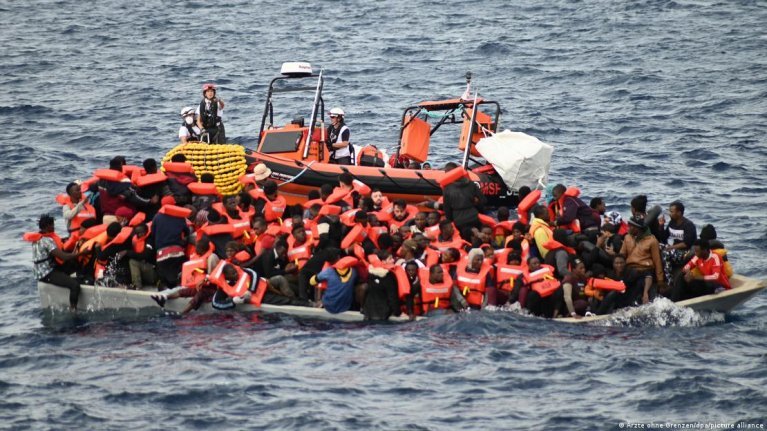It was another dramatic night on the central Mediterranean Sea on Friday with NGO Doctors Without Borders rescuing nearly 200 migrants in five operations.
One of the survivors said they had spent four days stranded at sea after the boat they were on suffered engine failure.
Some people in distress on a fiberglass boat had to be plucked from the water.
A total of 191 migrants were brought to safety on board the NGOs ship, Geo Barents, which is now sailing towards the Italian port of Salerno.
The Central Mediterranean route (the route from Algeria, Egypt, Libya, and Tunisia to Italy and Malta) has long been the deadliest migration route in the world. According to the International Organization for Migration (IOM) nearly 2,500 people died or went missing as they attempted to cross the stretch in 2023.
Every year, hundreds of thousands of people attempt to reach Europe from North Africa by crossing the Mediterranean Sea.
The UN’s International Organization for Migration’s Missing Migrants Project found that 3,041 people were dead or went missing in the Mediterranean last year.
Here are some reasons why some persons undertake to cross the deadliest migration route in the world:

Evidence of desperation
When people are willing to take the risk of crossing the Mediterranean it is a testimony of their desperation. They know that there is a chance they might not survive, and they know they risk being sent back. But with an untenable situation in many of these people’s home countries, with conflict and hunger on the rise, they see no other options.
Seeking protection
People are dying at Europe’s doorstep because there are virtually no safe ways for them to seek protection in what has become a European fortress. Seeking asylum is a human right. All people have a right to seek asylum and get individual review of their asylum claims, in line with the Refugee Convention and the EU Charter of Fundamental Rights. The Refugee Convention explicitly recognizes that refugees may be compelled to enter a country of asylum irregularly to seek protection.
Fleeing war, conflict, climate change and poverty
In addition to war and conflict, disasters and climate change are increasingly a driver for human mobility as some areas become unlivable and traditional livelihoods are no longer sustainable. This is also one of the reasons many people in North Africa seek to move.
Some Top 10 countries of origin for these migrants include:
Guinea (12%), Tunisia (11%), Côte d’Ivoire (10%), Bangladesh (8%), Egypt (7%), Syria (6%), Burkina Faso (5%), Pakistan (5%), Mali (4%), Sudan (4%), Others: 27%
Source: (UNHCR figures from 2023)
In 2023, 157,651 people arrived in Italy by sea.
The Deteriorating economic situation in North Africa
The increased number of people crossing via the Central Mediterranean Route is linked to the rapidly deteriorating economic situation in North Africa, particularly Tunisia and Egypt. Not only do these countries host a significant number of migrants, refugees, and asylum-seekers, but also an increasing number of disenfranchised young people who do not see prospects of building a secure future for themselves in their home countries.
Hotspot Tunisia – “The Tunisian Corridor”
Recent figures show that Tunisia has overtaken Libya as the main departure point for migration towards Europe. Of the more than 150,000 people who crossed the Central Mediterranean in precarious boats in 2023, more than 62 percent left from the beaches of Tunisia, according to Frontex, the EU border agency. In the summer of 2023 — when all records were broken — 87 percent left from Tunisia. The rest departed from Libya, which was previously the main route. The water between Tunisia and the Italian island Lampedusa is now named as the “Tunisian Corridor”.
Discrimination and lack of protection
The weak legal frameworks across Libya, Egypt, and Tunisia, mean that refugees, asylum-seekers, and migrants face challenges accessing basic services. Their rights are not protected, and they face real difficulties in building a new future for themselves. In addition, they face increasing discrimination and community tension, particularly if they are perceived to be competing with vulnerable people for services and jobs.
Tunisia in 2023 intercepted more than 75,000 people on the move while they were attempting to enter Europe via the Mediterranean Sea route to Italy. This is more than double the number in 2022, according to the Tunisian National Guard.
The EU Asylum and Migration Pact, which was proposed in September 2020 and agreed upon between the European Parliament and the Council in December 2023, is, according to the EU “designed to manage and normalize migration for the long term, providing certainty, clarity and decent conditions for people arriving in the EU.”
More protection measures must be put in place to avoid more loss of life and safe opportunities for people who are forced on the move.
The Norwegian Refugee Council’s Human Mobility Hub works with a wide network of local partners in North Africa to help people on the move access basic services and rights. The mission of the hub is to build a network of empowered communities and partnerships to protect the rights and dignity of people on the move and those hosting them.
The hub and its network of around 40 partners, including many migrant and refugee-led initiatives, co-design and co-implement projects to enhance legal protection, create opportunities for self-reliance, and share capacity. In addition, the hub and partners also provide emergency assistance to vulnerable people on the move.
Discover more on this story by visiting our website www.globalafricantimes.com
Source: African News, Norwegian Refugee Council NRC




